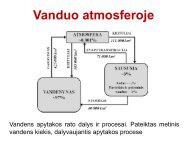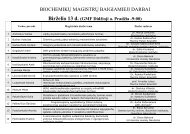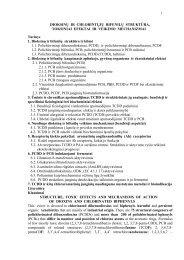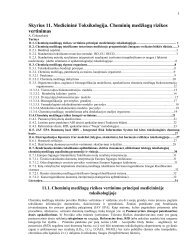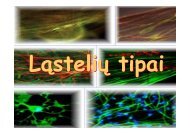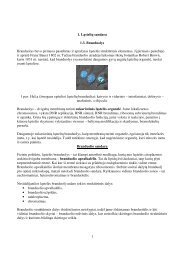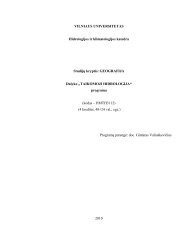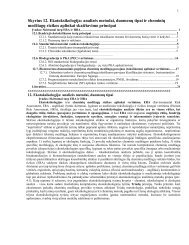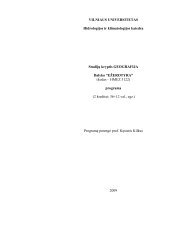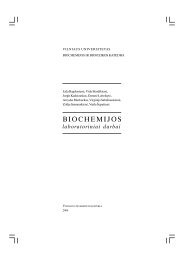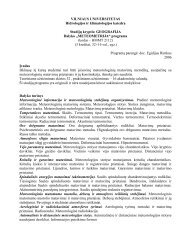Species and Their Formation - Laboratory of Visual Systems
Species and Their Formation - Laboratory of Visual Systems
Species and Their Formation - Laboratory of Visual Systems
You also want an ePaper? Increase the reach of your titles
YUMPU automatically turns print PDFs into web optimized ePapers that Google loves.
SPECIES AND THEIR FORMATION 489ciation <strong>and</strong>, at the same time, have evolved long floral nectarspurs—tubular outgrowths <strong>of</strong> petals that produce nectarat their tips. Animals pollinate these flowers while probingthe spurs to collect nectar. The length <strong>of</strong> the spurs <strong>and</strong> the orientation<strong>of</strong> the flowers influence how efficiently pollinatorscan extract nectar. Two species, Aquilegia formosa <strong>and</strong> Aquilegiapubescens, that grow in the mountains <strong>of</strong> California canproduce fertile hybrids. A. formosa has pendant (hanging)flowers <strong>and</strong> short spurs (Figure 24.11a); it is pollinated byhummingbirds. A. pubescens has upright flowers <strong>and</strong> longspurs (Figure 24.11b); it is pollinated by hawkmoths.Investigators tested discrimination among these flowersby hawkmoths by turning A. formosa flowers so that theywere upright. Hawkmoths still visited mostly A. pubescensflowers (Figure 24.11c), probably because the flowers <strong>of</strong> thetwo species differ strongly in the color <strong>of</strong> light they reflect.Genetic analyses <strong>of</strong> hybrids between the two species showthat the color differences are caused by a small number <strong>of</strong>genes. Thus, although these two species are interfertile, hybridsrarely form in nature because the two species attractdifferent pollinators.Postzygotic barriers operate after fertilizationIf individuals <strong>of</strong> two different populations overcome prezygoticreproductive barriers <strong>and</strong> interbreed, postzygotic reproductivebarriers may still prevent gene exchange. Geneticdifferences that accumulated while the populations were isolatedfrom each other may reduce the survival <strong>and</strong> reproduction<strong>of</strong> the hybrid <strong>of</strong>fspring in any <strong>of</strong> several ways:Hybrid zygote abnormality. Hybrid zygotes may fail tomature normally, either dying during development ordeveloping such severe abnormalities that they cannotmate as adults.Hybrid infertility. Hybrids may mature normally, but beinfertile when they attempt to reproduce. For example,the <strong>of</strong>fspring <strong>of</strong> matings between horses <strong>and</strong> donkeys—mules—are strong, but sterile; they produce no descendants.Low hybrid viability. Hybrid <strong>of</strong>fspring may simply surviveless well than <strong>of</strong>fspring resulting from matingswithin populations.(a) Aquilegia formosa(c)Number <strong>of</strong> visits by hawkmoths140120100806040200A. pubescens(normalorientation)(b) Aquilegia pubescensA. formosa(upright)A. formosa(normalorientation)24.11 Hawkmoths Favor Flowers <strong>of</strong> One Columbine <strong>Species</strong>Flowers <strong>of</strong> Aquilegia formosa are normally pendant (a), while those <strong>of</strong>A. pubescens are normally upright (b). The plants can interbreed, butthe hawkmoths that pollinate A. pubescens distinguish between flowers<strong>of</strong> the two species, even when A. formosa flowers are experimentallymodified to be upright (c).If hybrid <strong>of</strong>fspring survive poorly, more effective prezygoticbarriers may evolve, because individuals that mate with individuals<strong>of</strong> the other population will leave fewer surviving <strong>of</strong>fspringthan individuals that mate only within their own population.This strengthening <strong>of</strong> prezygotic barriers is known asreinforcement. Reinforcement is difficult to detect experimentally,but it can be detected by using the comparativemethod (see Chapter 1). If reinforcement is occurring, thensympatric pairs <strong>of</strong> species should evolve prezygotic reproductivebarriers more rapidly than allopatric pairs <strong>of</strong> speciesdo. In a study <strong>of</strong> related sympatric <strong>and</strong> allopatric species <strong>of</strong>Drosophila, this was shown to be the case (Figure 24.12).We can observe speciation in progressSince speciation is a gradual process, we can find many examples<strong>of</strong> populations at different stages on the way to completereproductive isolation. A good example <strong>of</strong> speciation inprogress is found in a picture-winged fruit fly (Rhagoletispomenella) in New York State. Until the mid-1800s, these fruitflies courted, mated, <strong>and</strong> deposited their eggs only onhawthorn fruits. The larvae recognized the odor <strong>of</strong> hawthorn



